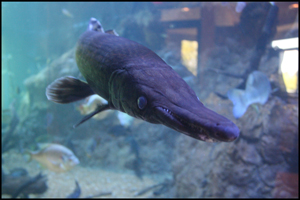
Article by Sarah Reddick – Photographs by Nature Humphries
Local Girls Visit North Mississippi Fish Hatchery
(And you should, too!)
 Enid, Miss. (TLV) – There are so many unique places to visit within driving distance for the residents of Oxford. In the next few issues the staff of TLV will be scouting out some of these destinations to get the scoop for those of you who’ve been bitten by the summertime travel bug.
Enid, Miss. (TLV) – There are so many unique places to visit within driving distance for the residents of Oxford. In the next few issues the staff of TLV will be scouting out some of these destinations to get the scoop for those of you who’ve been bitten by the summertime travel bug.
The Mississippi Department of Wildlife, Fisheries & Parks operates the North Mississippi Fish Hatchery on Lake Enid. Right off of Highway 6 on Exit 233, about 36 miles southwest of Oxford in Yalobusha County, sits an educational wonderland amid Lake Enid’s 220 miles of almost pristine shoreline. The lake is popular with fishermen because the shallow, rich waters of the lake are conducive to producing large numbers of fish. The world record crappie was caught at Enid Lake, and it weighed in at 5 pounds 3 ounces.
 The facility is a modern, sprawling complex that is made up of the Visitor Education Center, the hatchery building, and twelve 1-acre production ponds that contain fish that are indigenous to Mississippi. Water to the production ponds is supplied by a pipeline from Enid Lake and two groundwater wells. Visitor center director Emily-Jo Wiggins took us on a tour and answered our questions.
The facility is a modern, sprawling complex that is made up of the Visitor Education Center, the hatchery building, and twelve 1-acre production ponds that contain fish that are indigenous to Mississippi. Water to the production ponds is supplied by a pipeline from Enid Lake and two groundwater wells. Visitor center director Emily-Jo Wiggins took us on a tour and answered our questions.
When you first walk into the center you see a 10,000 gallon aquarium that holds several types of fish that can be found in Mississippi lakes as well as some that are found in the river systems, like the alligator gar. One fish seemed to be particularly friendly, its face pressed to the glass, a big mouth buffalo from Lake Enid that weighs 57 lbs. The visitor center also has a big game fishing simulator, multiple displays designed to be both educational and entertaining, and art by prominent Mississippi artists.
 A state fish hatchery collects, incubates, and hatches eggs. When the fish grow to a bigger size, fingerling size, they are then stocked into public waters. Types of fish stocked by the Mississippi hatchery system include paddlefish, grass carp, walleye, bluegill, channel catfish, crappie, largemouth bass, and striped bass.
A state fish hatchery collects, incubates, and hatches eggs. When the fish grow to a bigger size, fingerling size, they are then stocked into public waters. Types of fish stocked by the Mississippi hatchery system include paddlefish, grass carp, walleye, bluegill, channel catfish, crappie, largemouth bass, and striped bass.
We were taken on a tour of the hatchery building as well. The hatchery building contains 36 holding tanks and 40 incubation jars. Some of the jars had translucent eggs bubbling around inside of them, made buoyant by filtrations systems pumping air into them. Emily-Jo pointed out fish that had very recently hatched and compared them to “little lint fibers.” They were almost invisible. Another hatchery employee lifted a paddlefish out of one of the tanks in a net so he could point out some of its unusual features.
 We were surprised to learn, after visiting one of the 80 foot outdoor raceways holding koi fish, that koi are used as food fish. Most people think of this brightly colored Japanese carp variety in relation to decorative ponds, but they are also used as food fish because koi are hardy and can produce thousands of offspring from a single spawning.
We were surprised to learn, after visiting one of the 80 foot outdoor raceways holding koi fish, that koi are used as food fish. Most people think of this brightly colored Japanese carp variety in relation to decorative ponds, but they are also used as food fish because koi are hardy and can produce thousands of offspring from a single spawning.
Emily-Jo gave us some catfish food and took us out behind the visitor center to a pond stocked with catfish. The catfish writhed near the surface as soon as our pellets hit the water, the sun glinting off their slippery bodies. “We have had children come by with food in their hands, and catfish have eaten it right out of their hands,” she told us. “We open this pond once a year for a youth rodeo and also for a nursing home rodeo. Last year there were 293 kids out here for the youth rodeo.”
The center also offers programs and workshops that are open to the public. Visitors have the option of a self-guided tour or a guided tour. Groups can schedule a guided tour in advance by visiting their website at http://www.mdwfp.com/north-ms-fish-hatcheries.aspx




